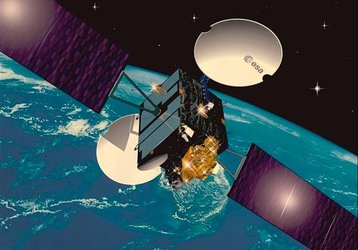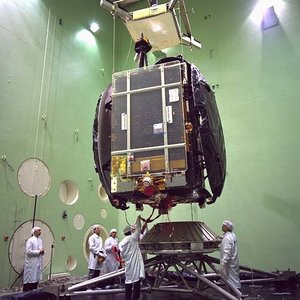
Artemis Overview '98
Artemis, the Advanced Data-Relay and Technology Mission Satellite, is the latest and most sophisticated telecommunications satellite to be developed by ESA. Equipped with sophisticated radio systems, Artemis will also use laser systems to transmit data directly between satellites. At eth time of the production of this video, it was expected that a Japanese H2A rocket will push Artemis into orbit by February of the year 2000; however due to delay Artemis was launched by Ariane in 2001. This video provides a general overview of the Artemis satellite, how it will work, and why it is necessary. The video includes:
0:09-1:15 Satellite assembly, integration, test and verification, at different integration factories across in Europe, including Alenia Space, in Rome. It is explained that Artemis is full of innovative technology illustrated with nice videos from assembly halls and test systems.
1:15-1:35 Artemis also involves new international cooperation between Europe and Japan. Artemis was originally scheduled for launch on a Japanese H-IIA rocket under a cooperative agreement with the Japanese Space Agency, NASDA. The video is presenting the H-IIA rocket launcher. However, development delays with the launcher caused ESA to review its launch options during the second half of 2000. Artemis was launched on an Ariane rocket in summer 2001 from the European launch base in Kourou, French Guiana, South America.
1:35-3:25 General introduction to satellite telecommunication and ESA role, and telecommunications satellites in everyday life. Mention also the massive US involvement in this field. Very well know are the MARECS satellites, in use by EUMETSAT, and the ECS satellites, in use by Eutelsat (the ECS satellites have been renamed Eutelsat). Eutelsat introduced satellite direct TV to cable networks throughout Europe.
3:25-3:47 ESA’s OTS was the world first 3-axis stabilized communication satellite. The success of this technology standard set the standard for over 30 European satellites.
3:47-3:58 Olympus is another example supporting direct broadcasting to home television.
3:58-4:23 EGNOS will augment the quality of the US GPS and the Russian GLONASS navigation satellite systems. Illustration: video animation.
4:23-4:32 With ESA projects the European industry would not be a world player on today’s and tomorrow’s marked.
4:32-5:12 Neil Kenneth European Commissioner for Transport explains (in English) the importance for the European continent to be involved in the development of satellite technology. He stresses that everyone in the World will benefit from the effort taken by Europe in development of new technology and satellite systems.
5:14-5:44 Artemis included many useful technological improvements, e.g. ion thrusters. Satellite will weigh 3000 kg. Launch was back then planned in Japan in late 1999.
5:44-6:22 Artemis’ orbital position will be at 21.5 degree East above Equator. It will include three major functions: (1) send high-data rate communication between satellites, (2) transmit accurate navigation information to e.g. car from EGNOS, and (3) provide voice and data communication between mobiles, mainly for cars, trucks, trains and ships.
6:22-7:26 Artemis Mobile Communication works in the L-band means antenna on ground for communication can be small and simple. As the L-band is a scarce resource Artemis optimise the use in an unique way, using different beams covering different parts of Europe. The objective is to provide better and more advanced mobile communication in Europe.
7:26-8:25 Artemis Satellite Navigation package include a stand-alone GPS-GLONASS compatible navigation signal, based on EGNOS. This is done in collaboration with European Commission and Eurocontrol. The technique is explained how Artemis will use the EGNOS signals, with animated videos
8:25-10:14 Artemis Data Relay Services provides communication directly between satellites, between low-orbit satellites and ground. This will support missions like SPOT, ENVISAT and ISS. The principles and advantages are explained. Artemis can communicate with other satellites using radio beams and for the first time, using the laser beam. It is the first time in space to use the laser communication technology, named SILEX, on satellites and has been developed by ESA.
10:14-10:26 ESA has equipped its Envisat satellite and 4 Spot satellites with Artemis terminals, to make use of the Artemis data relay functionality.
10:26-12:32 Japan Space Agency NASDA presentation. Artemis is also made compatible with the Japanese data relay system.
12:32-13:17 Artemis orbit illustrated by video animation







